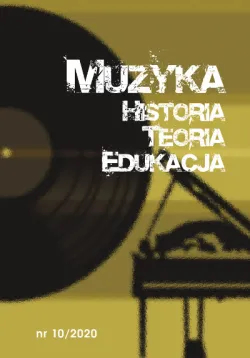Muzyka pasyjna w kościele Wniebowzięcia Najświętszej Marii Panny w Katowicach
DOI:
https://doi.org/10.34767/MHTE.2020.01.05Abstrakt
Lent in the Catholic Church and in Protestant Churches is a time of reflection over the salutary Passion of Jesus Christ, the Redeemer and the final things of man. These reflections are accompanied by a special musical setting of services. In contemporary songs sung, for example during the service of Gorzkie Żale, traces of Gregorian chant as well as ancient church scales are easily perceived. These passion songs deeply rooted in tradition undeniably strongly influenced the work of many Polish composers of different periods. Rev. Bartosz Zygmunt, initiator and implementer of many artistic projects in Upper Silesia, refers to such a lively and extremely rich tradition of Polish singing during the Lent period, and especially choral songs. On March 26, 2018, a special concert of Lent and Passion music was held at the Church of the Assumption of the Virgin Mary in Katowice. Its main goal was to indicate the place and role of music in the celebration of the liturgy of the Lord’s Supper, which is part of the Paschal Triduum being the central celebration of the Roman Catholic Church. The uniqueness of the concert was also the fact that it was the crowning achievement of the artistic work of Rev. Bartosz Zygmunt and was a significant point in the process of the doctoral dissertation in the discipline of artistic conducting. The implementation of the artistic work was proof of scientific research, as evidenced by the written dissertation of Rev. Bartosz Zygmunt’s The role of music in the celebrations of the Lord’s Supper liturgy on the example of choral works of Polish composers, created after the Second Vatican Council. Moving in a strictly defined circle of Polish composers who created after the Second Vatican Council and in relation only to choral music, such a choice was not easy at all. Contrary to appearances, not many works were created during this period that could be performed in the liturgy of Holy Thursday. Composers are much more often focused on the passion content of the Good Friday liturgy. In addition, the selection of works was very well thought out due to not only the value of the text, but also for practical reasons (e.g. length of time that does not disturb the time and proportion of the liturgy). It should be noted that during the concert the conductor properly laid out the space of the temple, placed both choirs relative to each other and to the organs. He provided performers with adequate comfort of mutual hearing and eye contact, and good reception for listeners. He did not abuse the dynamics of the organs, even though they were poorly heard on the empora, which hindered cooperation with choristers. From the position of listeners, however, the dynamics relations were appropriate. In addition, they fit well with the recommendations of the Polish Bishops’ Conference Instruction, which allows the use of organs in the Holy Thursday liturgy only as an instrument supporting singing. The theoretical dissertation was written by a priest and a conductor in one person. The author skillfully combined his own liturgical and musical experiences. The doctoral student gave in his work an example of a proper compilation of musical material which, even though it contains songs written by several composers of both the older and younger generation, creates a stylistically and expressively monolith, in terms of content, music and aesthetics. Both the concert and the theoretical dissertation are proof of the rich musicological content, an interesting concept of analysis of the songs selected for concert presentation and an innovative approach to the methodical and performance issues of the repertoire relating to the celebration of the Lord’s Supper liturgy. An important advantage was the fact that the Choir of the Karol Szymanowski Academy of Music in Katowice (divided into two performing groups) prepared and led by Rev. Bartosz Zygmunt reacted to the smallest elements resulting from the manual gesture, which emphasized many interpretative details and contributed to artistic success.

